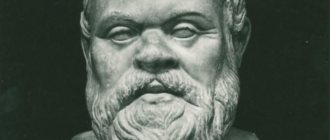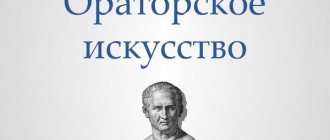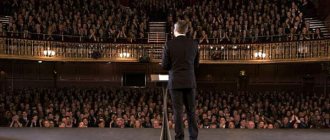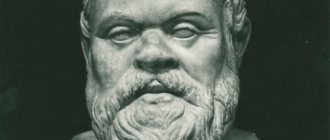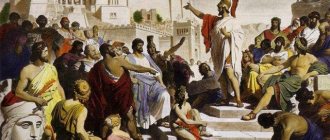Rhetoric in the Middle Ages
The main feature of the medieval era is its deep relationship with religion.
The main type of oratory for this period became spiritual eloquence.
Church ministers retell sacred dogmas and biblical legends.
The main method of influencing the listener is suggestion, not persuasion.
Homiletics is actively developing: the auxiliary science of theology explains church theory and introduces preaching literature.
Noteworthy are the works of the Spanish Archbishop Isidore of Seville and the Anglo-Saxon chronicler and monk the Venerable.
In their works, rhetorical terminology is clearly explained, and the material is systematized. The Church during this period is considered the largest feudal landowner. Everything was subordinated to theology: social institutions, philosophy, art, education.
With the advent of higher educational institutions, university eloquence appears. It is also closely connected with the church and is based on scholasticism. This philosophy relies entirely on religious authorities and neglects everyday experience.
John Chrysostom is considered one of the greatest writers of that time: he perfectly combines an ancient rhetorician and a Christian theologian.
He was considered the protector and patron of the weak and poor, as well as those whose work is related to oratory - teachers and lawyers.
Eloquence in the temple and in the scientific department
In the Middle Ages, a paradoxical situation arose: the ancient world and its achievements were declared by the church to be “sinful,” “pagan,” but at the same time, many of the achievements of ancient Greek and Roman thinkers were actively used by European theologians. Thus, clearly with an eye to the works of Aristotle and Cicero, many of the works of Thomas Aquinas, Augustine the Blessed and other “fathers of the church” were compiled. The need to “carry the word of God” and to expound church dogmas to the illiterate gave birth to talented preachers, who sometimes had greater influence on the flock than the ruling kings and emperors - the already mentioned Savonarola can be cited as an example. Rhetoric also played an important role during the years of conflicts between different religious movements.
John Chrysostom is a famous theologian, whose sermons are considered one of the pinnacles of church eloquence
In the Renaissance and Modern times, when man was proclaimed the main value, and science and reason were the main tools for understanding the world, rhetoric mainly served to popularize science, to explain what was considered a “miracle” just a few decades ago. In addition, rhetoric plays an important role in literature: for example, the works of Cardinal Pietro Bembo and the writer Baldassare Castiglione, prominent representatives of the Renaissance, contain many discussions on the stylistics of speech, the structure of the popular language, and the role of imagery and wit in presentation.
“Short speeches are always more meaningful and capable of causing a strong impression” (Maxim Gorky)
At the end of the 17th - in the 18th centuries, rhetoric became more “highly specialized”, individual areas were more clearly visible in it, such as political, theological, scientific, judicial, literary and even secular rhetoric, because, for example, all sorts of tutorials on etiquette and the art of “easy conversations in society" also had to do with eloquence! The French writer and theologian Francois Fenelon, in his work “Discourse on Eloquence,” extols such virtues of the orator as clarity of thought, clarity of presentation, “poetry without excess.”
Auguste Couder. Opening of the Estates General on May 5, 1789. 1839. This meeting, convened by King Louis XVI to solve the financial problems of the state, and the speeches made at it partly became one of the reasons for the Great French Revolution
Famous religious preachers of the Middle Ages:
- Augustine the Blessed
- John Chrysostom
- Basil the Great
- Trouble the Honorable
- Isidore of Seville
Manuals on rhetoric of the Renaissance and modern times:
- "Rhetoric", Philip Melanchthon
- "The Art of Poetry", Nicolas Boileau
- "The Sources of French Eloquence", Chabanel
- The Garden of Eloquence, Henry Peachum
Rhetoric in the Renaissance
During the Renaissance, rhetoric received a new round of development. Business and parliamentary eloquence appears; judicial - is reborn. During the Renaissance, the emphasis is on human individuality.
The orator-philosopher Cicero becomes a role model. And although he was not an original thinker or the creator of his own philosophical system, the writer sought to introduce people to the latest events and provide material for meaningful reading and self-education. Rhetoric is closely intertwined with literature.
The personality of man and his freedom began to manifest themselves more clearly than ever in speech. People tried to discern rhetorical possibilities in their native language, relying on the impressive experience of ancient authors.
The fiction of that time strives to improve speech culture, enhances verbal sensitivity, tries to show the expressive capabilities of language and instills an aesthetic taste for the word.
A classic example of Renaissance oratory is the monologues of Hamlet, Juliet and other Shakespearean heroes.
Rebellious sermons are becoming popular in the church environment. The Italian monk Savonarola actively criticizes the Vatican and the luxury of the Catholic Church. And Jan Hus, holding the position of rector of the University of Prague, delivers his sermons in simple folk language and knows how to skillfully change the form of presentation of thoughts depending on the target audience.
The priest was considered a national hero of the Czech Republic. In his words people found justice and honesty. Hus carried out a reform of Czech spelling, after which books became available to the common classes.
Rhetoric is an integral part of the culture of any people. Thanks to this discipline, ideas and ideas for a particular historical society are affirmed.
At the same time, another important function is realized: rhetoric is a mediator between people and establishes mutual understanding between them.
Related posts:
- What is "War and Peace" about? Summary of the novel “War and Peace” by chapters. All answers...
- Rhetoric - traditional and modern Modern rhetoric - the origins of oratory. Rhetors of the times of Ramus and...
- Ancient Greek rhetoric The reasons for the emergence of the art of rhetoric in Ancient Greece. Its founders. Influence…
- Logorhythmic classes and correctional means By various means, speech therapy classes contribute to the effective correction of speech in children...
Introduction
Oratory is the art of constructing and delivering a speech in public with the goal of influencing an audience. A similar interpretation of oratory was accepted in ancient times. Oratory is also called the historically established science of eloquence and an academic discipline that sets out the fundamentals of oratory.
In ancient times, rhetoric was considered as the science of argumentation in public speech, necessary when discussing practical issues. Later, rhetoric was borrowed by the Romans, adapted to the needs of Roman society and improved not only as a stable system of scientific concepts, but also as an educational subject.
In the XVII–XIX centuries. Rhetoric began to be understood as the science of argumentation primarily in written speech: the social importance of oratory at this time decreased, and the importance of written literature - theology, religious and political journalism, philosophy, historical prose, documents - increased. Private rhetoric is gradually developing, in which the rules for creating specific types of works are formulated - court speeches, sermons, letters, business papers, historical, philosophical, scientific essays, etc.
In the second half of the 19th century, rhetoric was excluded from the education system, and its place was taken by the compulsory study of artistic works and the opinions of literary critics on various issues of public life.
Modern neo-rhetoric brings a return to the heritage of Christian culture, taking into account modern scientific knowledge.
All European rhetoric is based on ancient rhetoric. The works of Aristotle, Cicero and other authors of the ancient world had a huge influence on those who created rhetoric in other countries, including Russia.
Modern rhetoric
Of course, in comparison with ancient Greece and Rome, with Russia during the time of Lomonosov, the conditions in which rhetoric exists have changed somewhat. The social structure of society has become different, the political system has changed many times, and the languages that were once spoken by the “fathers of eloquence” have also undergone changes. Professions and areas of activity have appeared that simply did not exist 30-50 years ago...
Accordingly, rhetoric as a science has also been enriched with various directions and connections with related areas of human activity. Modern rhetoric is a much broader concept than the ancient “oratory.” But the basic rules, tasks and principles remained the same.
Engraving by E. Fessard and K. Wortman. M. V. Lomonosov. 1757. Lomonosov was the creator of a popular Russian textbook on rhetoric, used for many years by scientists, lawyers, and politicians
What definitions of rhetoric and what vision of its tasks do modern experts present to us?
Most manuals on the art of eloquence present the idea that the main task of modern rhetoric is the adequate and confident use of all types of words, which include oral presentation, written work, report, telephone or Internet communication. Rhetoric is also called the science of effective speech.
Effective speech is, first of all, one that corresponds to the speaker’s goal, that is, it is expedient. For example, if you want to attract new trading partners to your enterprise, it is unlikely that you will focus on the possible shortcomings of the products you produce during the presentation.
“Eloquence, like pearls, sparkles with content. True wisdom is laconic" (Leo Tolstoy)
Effective speech must have an impact on the listener. For example, a manager needs to encourage employees to work overtime. Of course, he will look for special inspiring, motivating words.
And finally, the conditions for effective speech include harmonization between the speaker and the audience, that is, rhetoric is also intended to smooth out possible negative perceptions (for example, during the same speech about overtime), to establish mutual understanding.
State Duma of Russia. Chairman of the Council of Ministers V.N. Kokovtsov speaks. December 1912. A lot depended on “political eloquence” in those years...
The art of persuasion is inseparable from the concept of “effectiveness”. Therefore, the study of rhetoric is impossible without numerous exercises and trainings aimed at a high level of interaction between the speaker and the audience. Moreover, it is the “art of persuasion” that some modern researchers call rhetoric, especially those who specialize mainly in trainings and presentations, and in business communication. However, this definition still seems narrow.
“There is no thought that cannot be expressed simply and clearly” (Alexander Herzen)
It is also very important to study the culture of speech - without relying on linguistic norms, without the ability to use the expressive means of language, a good speaker is unthinkable.
The formation of what basic skills is put in first place when studying rhetoric in our time?
- Quick perception of speech and any other information.
- Isolating the essence of this information.
- Operational expression of thought into speech and action.
- Ability to form a monologue.
- The ability to appeal to feelings, emotions, logic.
- Ability to conduct and manage dialogue.
- The ability not to succumb to “verbal provocations.”
- The ability to make your speech effective (the requirements for “effective speech” were discussed above).
A speech that made history
One of the best speeches in the history of rhetoric is the speech of Martin Luther King, leader of the black civil rights movement, “I have a dream.” He said it in 1963 from the steps of the Lincoln Memorial during the peaceful March on Washington for Jobs and Freedom protest.
“Word patterns” in Russia
Russian rhetoric had its own characteristics. Respect for figurative, bright, “fluid” speech has always existed in Rus'; it is enough to recall that the guest of honor at feasts was usually the storyteller... Russian chronicles, lives of saints, “teachings” compiled by princes for their heirs testify to the high mastery of the written word. Curious examples of the epistolary genre have also survived to this day, such as the correspondence of Ivan IV with Prince Andrei Kurbsky - the opponents clearly mastered the art of eloquence and knew how to use it!
Russian practical manuals on rhetoric were intended primarily for chroniclers and, of course, theologians. Both foreign works were used (we knew, for example, both the works of Aristotle and the works of the 17th century French Jesuit Noël Chabanel), and manuals compiled by compatriots. Thus, the works of Bishop Macarius of Vologda, Simeon of Polotsk, and Feofan Prokopovich were widely known.
“Rhetoric is the science of speaking and writing eloquently about any proposed matter, that is, presenting it with selected speeches and portraying it in decent words to such an end that listeners and readers can be convinced of its justice” (Mikhail Lomonosov)
Among the most famous books on rhetoric published in Russia is “A Brief Guide to Eloquence,” written by Mikhail Vasilyevich Lomonosov. Book one, which contains rhetoric, showing the general rules of both eloquence, that is, oratorio and poetry, composed for the benefit of those who love verbal sciences. This publication was published in 1748 and became one of the most popular for a long time.
In the 19th century, the development of rhetoric in Russia continued mainly pan-European trends. The teaching of rhetoric in educational institutions was stopped. Nowadays, we are gradually realizing that the art of eloquence belongs to that area of knowledge that, even without receiving practical application, plays a huge role in improving a person’s general culture and in shaping his life position. Who knows, maybe in a few years this discipline will become mandatory in schools, lyceums, colleges and universities?
Classics of rhetoric
In the 19th century, two textbooks were published in Russia, compiled by Nikolai Fedorovich Koshansky, a professor at the Tsarskoye Selo Lyceum: “General Rhetoric” (1818) and “Private Rhetoric” (1832). They were reprinted many times and were popular until the beginning of the 20th century.
Mysterious "legend"
In the 17th century, the work “The Tale of the Seven Free Wisdoms,” dedicated to grammar, dialectics, rhetoric, music, arithmetic, geometry, and astronomy, became popular in Russia. The author and the exact time of creation are unknown, there are versions that this is a translation from Latin; many researchers believe that this is the work of a Russian author. “The Tale” was published many times, both in its entirety and in parts, for example as part of textbooks.

